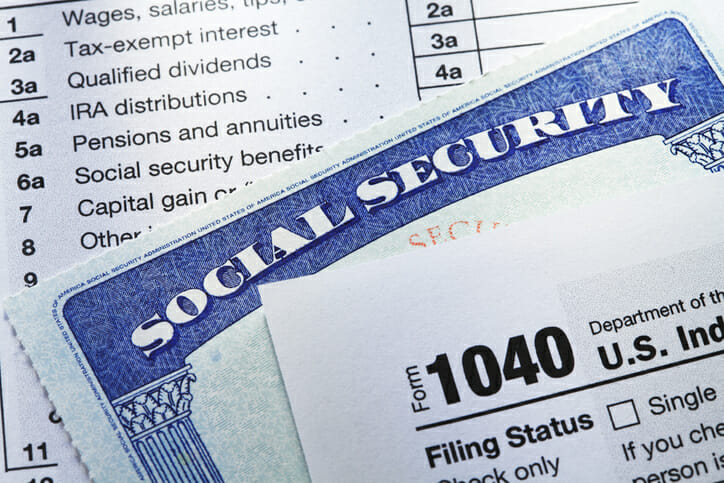Social Security income can be taxable at the federal level, but whether you have to pay taxes on your Social Security benefits depends on your income. If you have other sources of retirement income, such as a 401(k) or a part-time job, you may have to pay some income taxes on your Social Security benefits. If you rely exclusively on your Social Security checks, though, you may not pay any taxes on your benefits.
A financial advisor can help you understand how different sources of retirement income are taxed.
Are Social Security Benefits (Income) Taxable?
Your Social Security benefits could be taxable, depending on your situation. According to the IRS, the best way to see if you’ll owe taxes on your Social Security income is to take one-half of your Social Security benefits and add that amount to all your other taxable income plus your tax-exempt interest. This number is known as your combined income, and this is how it’s calculated:
Combined Income = Adjusted Gross Income (AGI) + Nontaxable Interest + 1/2 of Social Security Benefits
If your combined income is above a certain limit (the IRS calls this limit the base amount), you may owe tax on a portion of your Social Security benefits. These base amounts remain unchanged in 2026 because Social Security taxation thresholds are not indexed for inflation. The limit is $25,000 for single filers, heads of household, and qualifying widows or widowers with a dependent child. The limit is $32,000 for married couples who file jointly. If your combined income, calculated as your modified adjusted gross income plus half of your Social Security benefits, exceeds these amounts, up to 50% or 85% of your benefits may be taxable.
These fixed Social Security thresholds differ from general income tax brackets and standard deductions, which the IRS adjusts each year for inflation. For example, the standard deduction for single filers increases from $15,750 in 2025 to $16,100 in 2026. The standard deduction for married couples who file jointly increases from $31,500 in 2025 to $32,200 in 2026. 1
How to Calculate Your Social Security Income Taxes
If your Social Security income is taxable, the amount you pay will depend on your total combined retirement income and your income tax bracket. However, you’ll never pay taxes on more than 85% of your Social Security income.
If you file your income tax return as an individual with a combined income that’s less than $25,000, you won’t have to pay taxes on your Social Security benefits. Single filers with a combined income of $25,000 to $34,000 must pay income taxes on up to 50% of their Social Security benefits. If your combined income is more than $34,000, you will pay taxes on up to 85% of your Social Security benefits. 2
For married couples filing a joint return, you’ll pay taxes on up to 50% of your Social Security income if you have a combined income of $32,000 to $44,000. If you have a combined income of more than $44,000, you can expect to pay taxes on up to 85% of your Social Security payments.
If 50% of your benefits are subject to tax, the exact amount you include in your taxable income (meaning on your Form 1040) will be the lesser of either:
- half of your annual Social Security benefits OR
- half of the difference between your combined income and the IRS base amount
For example, let’s say you’re a single filer who receives a monthly benefit of $1,900, which is just under the average benefit for retired workers in August 2025. While your total annual benefits add up to $22,800 in 2025, imagine that you also have $18,600 in other income. As a result, your combined income would be an even $30,000 ($11,400 + $18,600).
The difference between your combined income and the base tax bracket (which is $25,000 for single filers) is $5,000. So the taxable amount that you would enter on your federal income tax form is $2,500, because it’s lower than half of your annual Social Security benefit and is half of the difference between your combined income and the base IRS amount.
The example above is for someone who’s paying taxes on 50% of their Social Security benefits. Things get more complex if you’re paying taxes on 85% of your benefits. However, the IRS helps taxpayers by offering software and a worksheet to calculate Social Security tax liability.
How to File Social Security Income on Your Federal Taxes

Once you calculate the amount of your taxable Social Security income, you’ll need to enter that amount on your income tax form. Luckily, this part is easy. First, find the total amount of your benefits. This will be in box 3 of your Form SSA-1099. Then, on Form 1040, you will write the total amount of your Social Security benefits on line 5a and the taxable amount on line 5b.
Which States Tax Social Security Benefits?
Everything above relates to your federal income taxes, which comprise the majority of your tax liability. Depending on where you live, though, you may also have to pay state income taxes on your benefits.
There are nine states that collect taxes on at least some Social Security income. Utah follows the same taxation rules as the federal government so you’ll pay the state’s regular income tax rates on all of your taxable benefits (that is, up to 85% of your benefits).
The other states also follow the federal rules, but offer deductions or exemptions based on your age or income. So in those nine states, you likely won’t pay tax on the full taxable amount. The other 41 states plus Washington, D.C. do not tax Social Security income.
Here’s a complete breakdown of the states that do and don’t tax Social Security.
| Taxes on Social Security Benefits | State |
|---|---|
| Taxed According to Federal Rules (for MAGI is over $45,000) | Utah |
| Partially Taxed (Exemptions for Income and Age) | Colorado, Connecticut, Montana, New Mexico, Minnesota, Rhode Island, Vermont, West Virginia |
| No State Tax on Social Security Benefits | Alabama, Alaska, Arizona, Arkansas, California, Delaware, District of Columbia, Florida, Georgia, Hawaii, Idaho, Illinois, Indiana, Iowa, Kansas, Kentucky, Louisiana, Maine, Maryland, Massachusetts, Michigan, Mississippi, Missouri, Nebraska, Nevada, New Hampshire, New Jersey, New York, North Carolina, North Dakota, Ohio, Oklahoma, Oregon, Pennsylvania, South Carolina, South Dakota, Tennessee, Texas, Virginia, Washington, Wisconsin, Wyoming |
The Impact of Roth IRAs on Social Security Taxes
If you’re concerned about your income tax burden in retirement, consider saving in a Roth IRA. Unlike many other retirement accounts, you save with after-tax dollars in a Roth IRA. Because you pay taxes on the money before contributing it to your Roth IRA, you will not pay any taxes when you withdraw your contributions.
You also don’t have to withdraw the funds on any specific schedule after you retire. This differs from distributions in traditional IRAs and 401(k) plans. These instead require you to begin withdrawals once you reach 73 (75 for people born in 1960 or later).
So, when you calculate your combined income for Social Security tax purposes, your withdrawals from a Roth IRA won’t count as part of that income. That could make a Roth IRA a great way to increase your retirement income without increasing your taxes in retirement.
Simplifying Your Social Security Taxes
During your working years, your employer probably withheld payroll taxes from your paycheck. If you make enough in retirement that you need to pay federal income tax, then you’ll also need to withhold taxes from your monthly income.
To withhold taxes from your Social Security benefits, you’ll need to fill out Form W-4V (Voluntary Withholding Request). The form only has seven lines. You will need to enter your personal information and then choose how much to withhold from your benefits. The only withholding options are 7%, 10%, 12% or 22% of your monthly benefit. After you fill out the form, mail it to an SSA office or drop it off in person.
If you prefer to pay more exact withholding payments, you can choose to file estimated tax payments instead of having the SSA withhold taxes. Estimated payments are tax payments that you make each quarter on income that an employer is not required to withhold tax from. So if you ever earned income from self-employment, you may already be familiar with estimated payments.
In general, it’s easier for retirees to have the SSA withhold taxes. Estimated taxes are a bit more complicated and will simply require you to do more work throughout the year. However, you should make the decision based on your personal situation. At any time you can also switch strategies by asking the SSA to stop withholding taxes.
Common Misconceptions About Social Security Taxes
Many retirees assume that Social Security benefits are always tax-free, but federal rules require you to include a portion of your benefits in taxable income once your combined income reaches the base amount. Since these base amounts do not adjust for inflation, more retirees find themselves paying some tax as their other income grows over time.
Another frequent misconception is the belief that the thresholds for taxing Social Security benefits work like standard tax brackets. The standard deduction and the income tax brackets change every year due to inflation adjustments, but the Social Security base amounts stay fixed at $25,000 for single filers and $32,000 for married couples who file jointly. This difference explains why combined income calculations often surprise retirees who are familiar with inflation-adjusted tax rules.
Some people also assume that Roth IRA withdrawals increase the taxes they owe on their Social Security benefits. Roth distributions do not count toward combined income, so they do not increase the percentage of benefits that may be taxable. This is one reason why Roth accounts can be helpful for managing taxable income in retirement.
Another misconception is that recipients owe tax directly to the Social Security Administration. In reality, the IRS determines whether a portion of your benefits is taxable and the tax is paid with your federal income tax return. You can have taxes withheld from your benefit payments or make estimated quarterly payments, depending on which method fits your situation.
Bottom Line

We all want to pay as little in taxes as possible. This is especially true in retirement when most of us have a set amount of savings. If you’re paying taxes on your Social Security, you probably have income from other sources and you’re not entirely dependent on Social Security to cover your living expenses. You can also save on your taxes in retirement simply by having a plan for managing your various sources of income.
Tips for Saving on Taxes in Retirement
- A financial advisor can help you build a retirement income plan. Finding a financial advisor doesn’t have to be hard. SmartAsset’s free tool matches you with vetted financial advisors who serve your area, and you can have a free introductory call with your advisor matches to decide which one you feel is right for you. If you’re ready to find an advisor who can help you achieve your financial goals, get started now.
- Planning ahead for retirement is incredibly important if you want to ensure your money lasts. SmartAsset’s retirement calculator can help you determine how your plans are looking.
- Be sure to account for your Medicare costs as you plan out your retirement income too. Check out SmartAsset’s guide to Medicare Part A, Part B, Part C and Part D.
Photo credit: ©iStock.com/Zinkevych, ©iStock.com/DNY59, ©iStock.com/DNY59
Article Sources
All articles are reviewed and updated by SmartAsset’s fact-checkers for accuracy. Visit our Editorial Policy for more details on our overall journalistic standards.
- “IRS Releases Tax Inflation Adjustments for Tax Year 2026, Including Amendments from the One, Big, Beautiful Bill | Internal Revenue Service.” Home, https://www.irs.gov/newsroom/irs-releases-tax-inflation-adjustments-for-tax-year-2026-including-amendments-from-the-one-big-beautiful-bill. Accessed 12 May 2025.
- “Publication 915 (2025), Social Security and Equivalent Railroad Retirement Benefits | Internal Revenue Service.” Home, https://www.irs.gov/publications/p915. Accessed 12 May 2025.
